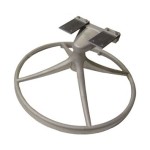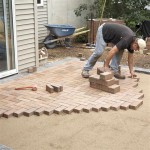Installing Patio Pavers On Concrete: A Comprehensive Guide
Installing patio pavers over concrete offers a versatile and attractive way to enhance your outdoor space. Whether you want to create a stylish new patio, cover an existing concrete slab, or add a touch of elegance to your backyard, this method provides a durable and visually appealing solution. This guide will delve into the essential steps involved in installing patio pavers over concrete, ensuring a successful and enjoyable project.
Preparing The Concrete Surface
A solid foundation is paramount for a long-lasting paver installation. Begin by thoroughly cleaning the concrete surface, removing any debris, dirt, or loose material. Utilize a pressure washer if available to effectively remove stubborn stains or grime. Next, check the concrete for any cracks, chips, or unevenness. These imperfections can hinder proper paver placement and lead to potential future problems. For minor cracks, apply a concrete patching compound. For larger cracks or unevenness, consider a leveling compound or consult with a professional for a concrete repair.
Creating A Drainage System
Proper drainage is crucial to prevent water accumulation, which can damage the paver installation and lead to frost heave in colder climates. Install a drainage system to ensure water flows away from the patio area. This can be achieved by creating a slight slope on the concrete surface, ideally toward a nearby drain or downspout. Alternatively, consider installing a drainage grid or trench to direct water away from the patio. If the concrete is already level, you can use polymeric sand, which is a type of sand that binds together to create a permeable surface that allows water to drain through.
Laying The Pavers Over Concrete
With a prepared and drained concrete surface, you can now lay the pavers. Begin by determining the desired pattern for your patio. For a simple and classic look, consider a running bond or herringbone pattern. More complex patterns require meticulous planning and measuring. Once you have chosen your pattern, lay out the pavers on the concrete surface without adhesive, leaving space for the joints between them. This will allow you to visualize the arrangement and make any necessary adjustments before permanently laying the pavers.
Utilize a rubber mallet to gently tap the pavers into place, ensuring they are level and flush with each other. For a professional finish, use a string line to guide the paver placement and maintain straight lines throughout the installation. Once the pavers are in position, use a high-quality paver adhesive to secure them to the concrete. Apply the adhesive evenly to the back of each paver and press it firmly onto the concrete, ensuring proper bonding.
After applying the adhesive, allow it to cure according to the manufacturer's instructions. Once the adhesive is fully cured, fill the joints between the pavers with polymeric sand. This sand compacts and hardens, creating a durable and aesthetically pleasing finish. Using a broom, brush the sand into the joints, ensuring they are completely filled. Once the sand is settled, hose down the patio to remove any excess sand and allow the sand to cure completely.
Additional Tips For Success
For a more secure and stable installation, consider using a layer of paver base beneath the pavers. This base will provide a cushion and help distribute weight evenly, minimizing the risk of settling or shifting over time. The choice of paver base will depend on the specific project requirements and local building codes. Consult a professional for guidance on the best type of paver base for your project.
Regular maintenance is essential to preserve the beauty and longevity of your paved patio. Sweep away fallen leaves, debris, and dirt regularly to prevent buildup and potential staining. In colder climates, use a snow shovel to remove snow from the patio, avoiding the use of sharp tools that could damage the pavers. Consider applying a sealant every few years to protect the pavers from the elements and enhance their appearance.

How To Cover A Concrete Patio With Pavers Diy Family Handyman

How To Install Patio Pavers Over An Existing Concrete Slab

How To Install Patio Pavers Over An Existing Concrete Slab

Why Installing Pavers Over Concrete Is A Bad Idea Pavertime

How To Install Patio Pavers Over An Existing Concrete Slab

Installing Pavers Over A Concrete Patio

How To Install Patio Pavers Over An Existing Concrete Slab

Pros And Cons Of Putting Pavers Over Concrete

Paver Installation Over Concrete Overlay Using Pavers

How To Install Concrete Pavers Rcp Block Brick
Related Posts








